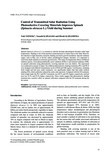Control of Transmitted Solar Radiation Using Photoselective Covering Materials Improves Spinach (Spinacia oleracea L.) Yield during Summer
JARQ : Japan Agricultural Research Quarterly
| ISSN | 00213551 |
|---|---|
| 書誌レコードID(総合目録DB) | AA0068709X |

本文フルテキスト
jarq56-1_67-75.pdf581.77 KB
Spinach (Spinacia oleracea L.) is resistant to cold but develops physiological disorders under high temperatures. Shading is one of the practical countermeasures to reduce heat in the field. However, the reduction in light intensities caused by shading can lead to growth retardation. Specific radiation ranges, such as blue, red, or far-red, induce morphological changes; therefore, it is important to selectively shade radiation to minimize growth losses. This study investigated the effects of different radiation spectra, from photosynthetically active radiation (PAR) to near-infrared radiation (NIR), on spinach cultivation using photoselective covering materials over rain shelters. The experiment was conducted in summer in Japan. Two different photoselective shading treatments (PS-1 and PS-2) were designed with different transmittance levels of PAR and NIR regions. Leaf biomass, including fresh weight and leaf area, under treatments, was significantly higher than that under uniform shading (US), which uniformly reduced the entire solar spectrum. Compared with the US treatment, fresh weight under the PS-1 and PS-2 treatments was 40.2% and 52% higher, respectively, and leaf area was 51.5% and 47.3% higher, respectively. These results suggest that photoselective shading treatment has a positive effect on spinach cultivation compared with the US treatment during the hot season.
| 刊行年月日 | |
|---|---|
| 作成者 | Yuki YONEDA Yasushi KAWASAKI Hiroki KAWASHIMA |
| 著者キーワード | heat insulation near-infrared radiation photosynthetically active radiation shading technique |
| 公開者 | Japan International Research Center for Agricultural Sciences |
| 受付日 | 2020-10-12 |
| 受理日 | 2021-03-01 |
| オンライン掲載日 | |
| 巻 | 56 |
| 号 | 1 |
| 開始ページ | 67 |
| 終了ページ | 75 |
| 言語 | eng |
